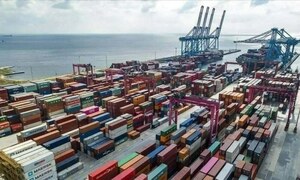CME Group Inc is talking to customers about potential changes to its biggest agricultural futures markets - corn and soyabeans - to address concerns the contracts' prices are not accurately reflecting the underlying US cash grain markets, the company's clients told Reuters. CME's review of the flagship Chicago Board of Trade futures contracts has not been previously reported. It marks the latest ripple effect from a glut of food commodities that has depressed prices, hurt US farmers' incomes and hobbled global grain traders.
CME Group is the world's biggest derivatives exchange and CBOT is the biggest agricultural exchange.
CME confirmed late on Monday that it was talking with customers as part of a routine review. The company said it was only in listening mode and that no changes were imminent. Customers told Reuters over the last two weeks that the company was talking with them about potential adjustments.
The discussions signal a new way in which the oversupply has been affecting day-to-day operations in the US farm sector. Farmers who rely on CBOT futures are beginning to lose faith in a critical hedging tool to offset the risk of raising crops and defend themselves against price swings. At issue for CME is a yawning discount for corn and soyabeans in the US cash markets, where farmers sell their physical harvests, relative to the company's soyabean and corn futures contracts.
Normally, the global futures benchmarks come together with cash prices at delivery points along the Illinois River when the futures contracts are expiring. But some have not in recent months, leading growers to question the futures markets' usefulness for hedgers. "We're reviewing our CBOT corn and soyabean futures delivery process to ensure these contracts continue to be effective hedging tools, with strong convergence for commercial market participants," spokesman Chris Grams said in an email.
In meetings and conference calls, two customers said, CME discussed possible changes to the corn and soya markets' storage mechanisms over the issue, including the implementation of a "variable storage rate" (VSR) system to adjust storage rates at the contracts' delivery points to bring the markets into sync. "It is harder to entice me into a futures contract because of the disconnect," said Iowa farmer Ron Heck last week, who now sells his soyabeans directly to grain buyers such as Archer Daniels Midland Co and Cargill Inc instead of hedging at the CBOT as he did five years ago.
Under the VSR system, storage rates at contract delivery points can be adjusted up or down to "reflect the true value being discovered in the physical market," according to CME - which has used the mechanism in past situations. CME implemented VSR after the soft red winter wheat contract failed to converge for nine contract expirations beginning in 2008. More recently, the company expanded VSR to hard red winter wheat futures, too.
Some traders oppose using VSR because they say it can encourage more storage and make products harder to buy. "You almost can't buy (wheat) with a gun because the storage returns are just too much," said a Midwest grain trader who requested anonymity to criticize the policy. Other market observers say it could be the most sensible solution for CME for corn and soya. "They need to go to VSR for corn and soyabeans," said Scott Irwin, agricultural economist at the University of Illinois.
A grain trader who discussed contract specifications with CME and requested anonymity said soyabeans failed to come together with cash prices in the last two contract expirations. They also are unlikely to converge in the next delivery cycle beginning on February 28, he said last week. In Ottawa, Illinois, where commodity traders ADM and Cargill have facilities near the Illinois River to receive deliveries of grain against futures contracts, soyabean cash prices during last year's autumn harvest were 58 cents per bushel below futures - the biggest discount in nine years.
BR100
11,813
Decreased By
-53.2 (-0.45%)
BR30
35,707
Increased By
9.7 (0.03%)
KSE100
113,383
Decreased By
-765.2 (-0.67%)
KSE30
35,681
Decreased By
-271.2 (-0.75%)

























Comments
Comments are closed.